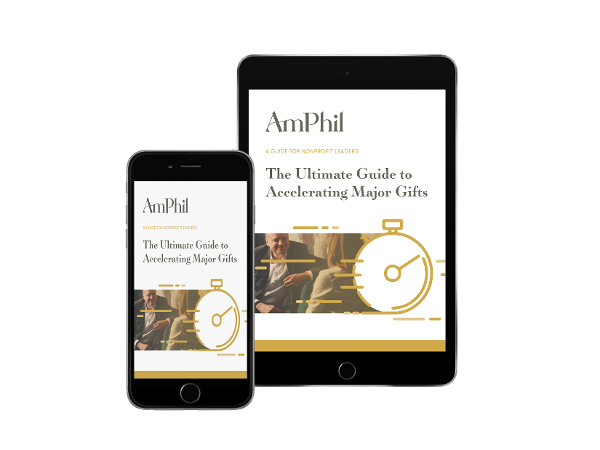
Almost every nonprofit has delved into the major gifts arena, believing that a unicorn is out there who will transform their nonprofit. But opening up the major gift fundraising spigot is more about consistency than it is about getting a single lucky break. Here, we’ll share proven insights and tips on how you can keep a steady flow of significant donors supporting your nonprofit and advancing your mission.
What Are Major Gifts?
Major gifts are usually defined as a single gift of $1,000 or greater.
Major gifts come in various forms, not just cash. They can be stocks, real estate, or even cryptocurrency. Understanding this diversity is critical to successful major gifts fundraising.
On average, major donors make up about 20% of an organization’s donor base—but contribute close to 80% of an organization’s total dollars raised. Regardless of whether your organization’s numbers match this figure exactly, one thing is clear: major gifts are critical for your organization to thrive. It’s these gifts that will support the bulk of your budget.
Where are Those Major Donors?
Contrary to popular belief, most of your major donors are not going to be the high-profile socialites or the famous foundation that everyone pursues. Major donors often arise from the ranks of those already supporting you—people who are aligned with your cause and passionate about your mission.
There are three main sources of major gifts:
- Current low-dollar donors: These are people who already donate to your organization, and who might have the capacity to give much more
- Lapsed donors: Either major donors or lower-dollar donors who used to give in the past but don’t currently.
- Cold major donor prospects: Those who might be able to make a large gift, but have never given to your organization before.
You can also cultivate current and lapsed donors, using direct mail, digital fundraising, or by inviting them to join a donor club.
When looking for a new major donor prospect, there are three crucial questions you should consider:
- Are they aligned with our organization’s mission?
- Can they make a large gift?
- Will it be possible to build a relationship with them?
In the best major donor prospects, these three keys—alignment, capacity, and accessibility—all need to be present.
Making the Ask: Establish a Repeatable Process for Major Donor Cultivation
You’ve done your research and identified some major donor prospects. Now it’s time to set up a meeting and ask for that big gift.
“Making the ask” is one of the most critical and stressful parts of being a fundraiser. But with some planning, organization, and persistence, your meetings with major donors can become easier more effective.
Before the Major Donor Meeting
- Do your homework: familiarize yourself with the person’s background, giving history, and any notes from past interactions.
- Develop a plan for how you want the meeting to proceed. Decide in advance a target amount to ask for. And be prepared with follow-up ideas for after the meeting that will let you stay engaged with the prospect.
During the Major Donor Meeting
- Put the donor at ease. Show you’re trustworthy and build rapport by starting with small talk and then moving on to asking questions. This builds a foundation for the relationship before you start pitching your organization.
- Ask questions, listen, and never assume things about the donor. Understanding the person’s vision for the future is not just a step in the process but a crucial opportunity to connect with your major donor on a deeper level. By understanding their vision, you can align your organization’s goals with their philanthropic interests, fostering a stronger and more meaningful relationship.
- Make a strong case for your organization, laying out the problem you’re trying to solve and the impact you’ve made. Bring donors into greater emotional engagement with your organization’s mission by sharing a few stories. Focus less on describing your program’s operations and more on how you want to change the world through your work.
- When it comes time for the ask, request a specific gift amount, not a range. You don’t want to leave potential money on the table!
- Give the donor time to respond after you ask, and be gracious no matter their response.
Follow-Up That Major Donor Meeting
Regardless of whether you receive a gift or not, you should make plans to follow up with the prospect after your meeting. If there were any action items from the meeting, then make sure you take care of those as soon as possible. If appropriate, you may want to tentatively schedule the next visit with the donor.
If you did receive a gift, be a good steward! Every major donor should receive:
- A phone call within 48 hours of their gift. This is a great opportunity to get to know your major donors better and give them an inside look at what’s happening in your organization.
- A follow-up thank-you email after the phone call
- A customized thank-you note, handwritten if possible
-
A gift receipt to commemorate the donation for tax purposes (this can be folded into the thank-you note)
A new donor welcome packet (if they’re a first-time donor), which could include an overview of the organization, a list of volunteer opportunities, and a calendar of upcoming events/programs.
Moving Your Major Gifts Fundraising Forward
Your goal as a major gifts officer is not to ask for large gifts each day; it is much more important than that. You want to cultivate personal relationships with your major donors and build a strong network of people passionate about your mission.
The secret to major gifts success? Keep moving forward. Accept that you will never be perfect and know that major donors are human, too; they have bad days. Do not take the no's too personally. If you only get yeses, you are not reaching out to enough donors.
If you consistently approach major gifts, you will succeed, achieve positive results, and help your organization. It won’t happen overnight. An intentional major gifts program that is well executed will take at least six months to get traction, so keep working. Personal relationships, networks, and an authentic approach to major gift fundraising are how every successful nonprofit moves the needle, and you will, too.


